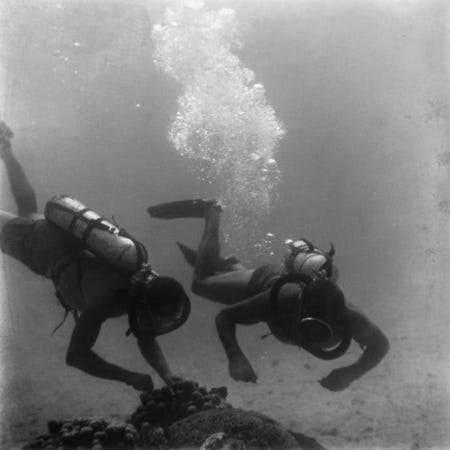The Broxton Project
A living history experiment
In many respects, 1953 was a landmark year: Elizabeth II was crowned queen of the United Kingdom, the Cold War was beginning to ramp up, From Here to Eternity was released by Columbia Pictures, the Korean Armistice Agreement was signed, and — among many other things — the first commercial dive watches were starting to be released.
A decade prior, French engineer Emile Gagnan and naval officer Jacques-Yves Cousteau had designed a revolutionary new “SCUBA” — self-contained underwater breathing apparatus — by modifying a gas regulator Gagnan had been tinkering with in his desk. Its distinctive twin-hose design, a temporary solution to a technical problem in Gagnan’s eyes, became a trademark and a patent. And to French expatriate and sporting goods store owner René Bussoz, it became gold.
U.S. Divers Company, founded by Bussoz, became the sole North American distributor of the “Aqua-Lung” in 1950. The earliest regulators were French-made, closely followed by Canadian-made models as Bussoz began moves to produce them in the United States. These first U.S. Divers regulators, made from 1950 to 1957, are commonly called “Broxton” Aqua-Lungs because of U.S. Divers’ Los Angeles address at that time.
These Broxtons shaped the early U.S. diving scene. The United States Navy adopted the regulators for service use, shaping a long tradition of SCUBA use, and the Scripps Institution of Oceanography used them in what became the first expedition to use SCUBA, forever reshaping the field of oceanography. While the Aqua-Lung was not invented in the United States, there was no better market for the revolutionary device.
This "Green Label" Broxton was manufactured in 1953 towards the end of that series' run. This series, produced between 1952-3, was the first Aqua-Lung fully made in the United States. It eventually found its way to a dive shop in central North Carolina. While it may seem like an odd place for a dive shop, it can trace its roots back to the early 1960s. Its owner got his first set of equipment in — and possibly this regulator — in 1953. The regulator turned 70 this past year and it seems only right to commemorate that. There is only one answer: a dive.
The guiding motto here at SEA-VUE is “diving into the past.” It is a two-part idea — looking to the past to understand the significance and impact of sport diving in (specifically American) history; but it is also trying to get as close to that past as possible, to experience the sport as early divers did. That first generation of divers to strap these new air lungs on their backs and slip beneath the surface is now rapidly fading away. With them goes their experiences and techniques. No, it cannot be any dive. It is not enough to simply put it in a pool and then leave it at that. It has to be as close to 1953-4 as possible. The goal of this experiment is to showcase and experience diving as it was at the genesis of the sport. To put it simply, it is as close to time travel as possible.
This requires a few moving parts. Perhaps foremost is the question of equipment. Here is the tentative list:
Twin 1/2” NPT 72s with a USD J-62 manifold on a USD blue harness
Oval mask
The ‘53 Aqua-Lung
Period swimwear, and
Green Churchill swim fins
As an acknowledgment of those first dives in 1943 (and a concession to the wallet), I am skipping an exposure suit. Warm water is thus a requirement. Plans have been made to attend an event in Florida in late July. A quick check of the map reveals a shore dive is thirty minutes away. Location, check.
Tasks and problems to be sorted prior to the dive:
The manifold is not the period-correct J2, it is a later J62. The look can be closely approximated by swapping the large knob (introduced on the ¾” valves in 1964) for the screw-type used on the J2.
The manifold also needs to be rebuilt — currently, the old screw-in burst disks are not budging
A reproduction harness needs to be acquired. The manufacturer has been identified, and planning is underway
The current mask is not entirely correct: a single-skirt round model would be better. This may be difficult to source in time
Swimwear. I have a pair of UDT shorts, but while these work for the period, they are not ideal
And lastly, perhaps of particular interest to readers, is the question of the watch: what would you choose for this dive?
It is a long road ahead, with only seven months to get there. Stay tuned for project updates as we near the date a legend dives again.




Can not wait!
"watch: what would you choose for this dive?"
I guess it should be either a Blancpain FF or a Rolex Submariner. However, seeing as you are taking some liberties on items such as the shorts, a Tudor BB54 would be fine,just fine.
Where in Florida are you going to be?